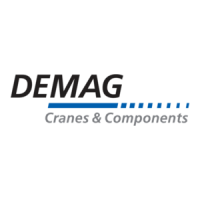– Pay attention to regulations pertaining to the correct loading of chains.
– Do not reach into rotating parts and maintain a sufficient safety distance to prevent clothing, parts of the body
or hair becoming entangled.
Load pick-up
– The load handling attachment and load must be flexibly suspended. Rigid connections cause uncontrolled
forces and lead to fatigue fracture. To protect the chain from impermissible torsion when the load turns, move‐
ment of the hook assembly/bottom block must not be restricted.
– The bottom block must not be twisted or turned over for 2/1 reeving arrangements; chain links facing the same
direction must be arranged opposite each other without being twisted.
– When attaching the load, ensure that loads or the load handling attachment do not slip out of the hook or that
loads do not fall over, fall apart, slip or roll off when being picked up and deposited.
– When the load is lifted, the hook must move to an upright position so that the safety catch is not loaded by the
load handling slings and, as a result, may be damaged.
– Transporting persons is not permitted.
– The load specified on the capacity plate indicates the highest permissible load which must not be exceeded. It
is the sum total of lifting load and load handling attachment. Only approved load handling attachments may be
used. The load capacity of the load handling attachment must not be exceeded.
Moving the load
– During lifting and travelling motions the operator must take a position which provides a free view on the danger
zone or a second person must be available who has a view on the danger zone.
– Hoists / trolleys / crane with push travel may only be moved by pulling or pushing on the load, bottom block or
load hook assembly. Never pull on the control pendant.
– Hand-moved loads must be guided by hand. The load must never be thrown.
– Do not handle suspended loads above persons.
– Do not pull or drag suspended loads at an angle. At an angle higher than 4° the chain drive may get damaged.
– Do not pull free fixed or obstructed loads with the chain hoist.
– Do not leave suspended loads unsupervised.
– Do not allow the chain to pass over edges or to be used as a load bearing sling.
– Do not allow loads to drop when the chain is in a slack condition.
– Vibration from the load being transported (e.g. when the load is deposited on vibrating machinery) must not be
transmitted to the crane.
– Chain hoists must be suspended in such a way that they do not collide with stationary equipment and structures,
e.g. when slewing pivoting cranes.
– Do not snatch the load at full speed.
– Avoid inching operation.
64
21480244/181209

